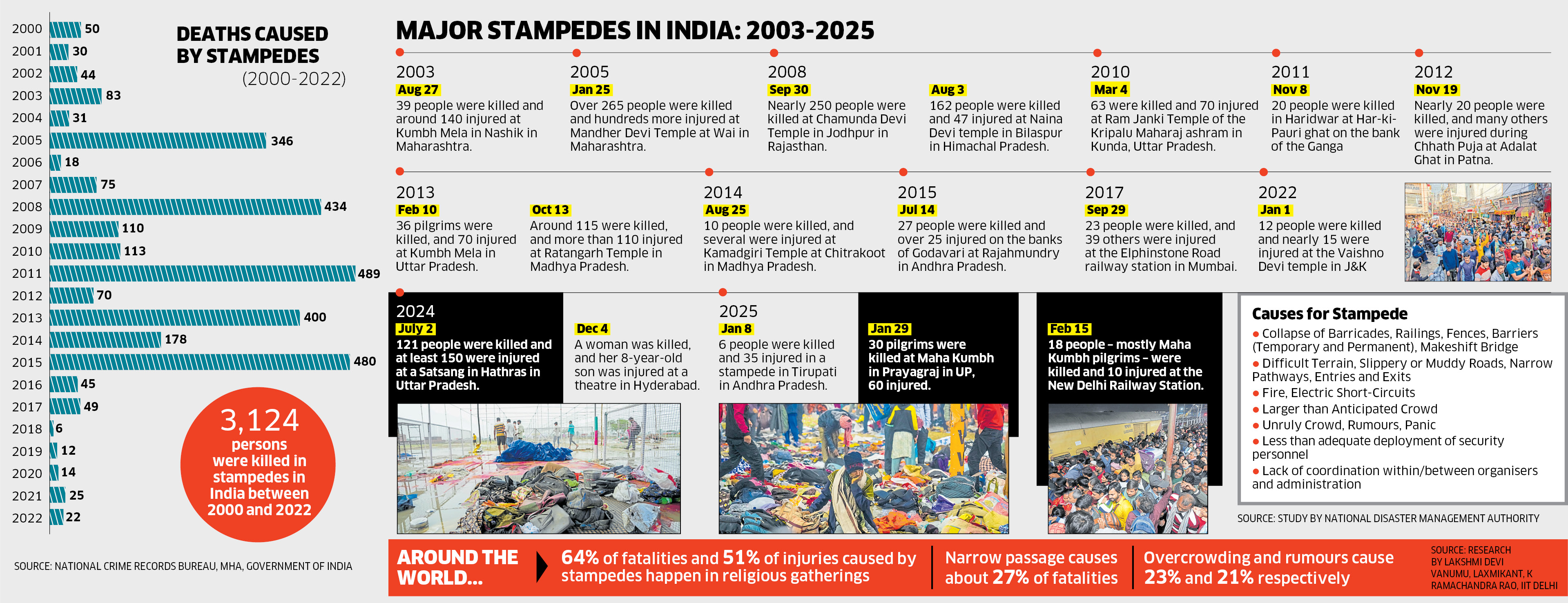Context
A tragic stampede recently struck the famous religious festival in Puri, Odisha, resulting in the loss of three lives and injuries to at least 50 devotees. Despite the massive security deployment and detailed planning, the event exposed serious shortcomings in crowd management, infrastructure readiness, and coordination between different authorities.
The incident took place during the Rath Yatra, one of India’s most significant religious gatherings, which draws lakhs of pilgrims from across the country and abroad. This year’s festival had an estimated 1.5 times the usual crowd size on the day of the mishap. Even with over 10,000 police personnel and 22 senior officers deployed, the administration failed to prevent a disaster that many observers called avoidable.
This stampede is not an isolated event but part of a broader pattern of crowd-related tragedies in India’s religious and cultural events. The circumstances highlight deep gaps in preparedness, anticipation, and the ability to manage large crowds in dynamic situations.
Key Highlights:
Factors Leading to the Stampede:
Investigations into the incident have pointed out multiple lapses:
- Lack of Coordination: There was a failure of clear communication and coordination between temple authorities and local administration. Even though the administration knew that the crowd would swell overnight, especially before the scheduled rituals, no effective measures were taken to stagger the inflow or create additional holding areas.
- Absence of Senior Officials: At the time of the surge, senior officials were reportedly absent, creating confusion on the ground about who was responsible for key decisions.
- Unanticipated Ritual Changes: Covering of the deity created a sudden rush among devotees who feared losing their chance for darshan, leading to overcrowding.
- Inadequate Medical Response: Witnesses stated that injured devotees did not receive prompt medical attention, contributing to the casualties.
This combination of administrative oversight and reactive crowd handling magnified the risk of panic and uncontrolled movement.
Insights from Past Incidents:
Stampedes at large gatherings are not new in India. In recent decades, similar tragedies have occurred:
- In 2003, a stampede at the Nashik Kumbh Mela killed 29 pilgrims.
- In 2005, over 290 people died during the Kalubai Yatra at Mandhardevi in Maharashtra.
- Other events, including the 2025 Mahakumbh Mela, have also seen fatal incidents linked to overcrowding, insufficient exits, and poor crowd flow management.
Experts and government agencies, including the National Disaster Management Authority (NDMA), have repeatedly emphasized that crowd behavior can be unpredictable. Anxiety, fear, excitement, or even a rumor can trigger panic. Without proactive measures, such emotions can turn large gatherings into tragedies.
Gaps in Crowd Management:
Several key issues surfaced in the Puri incident that reflect recurring problems:
- Reactive, Not Proactive Planning: Instead of anticipating crowd surges, most planning relies on reacting to problems after they arise.
- Inadequate Infrastructure: Narrow pathways, poorly marked entry and exit points, and lack of emergency exits make evacuation difficult.
- Poor Use of Technology: Despite technological advancements, real-time monitoring tools such as drones and density-mapping systems are not fully integrated into festival management.
- Limited Training: Many personnel deployed on the ground lack specialized training in handling massive crowds and responding to emergencies.
Recommendations from NDMA:
The NDMA’s 2014 report offers clear guidance on managing large gatherings. It identifies major risk factors and recommends a structured approach:
1. Controlling Inflow
o Use registration systems to limit the number of pilgrims entering the venue.
o Issue time-slotted passes to stagger arrivals.
2. Regulating Crowd Movement
o Create wide, clear pathways and set up sturdy barricades.
o Use signage and public announcements to direct movement.
3. Managing Outflow
o Design well-marked exit routes.
o Guide devotees systematically to prevent sudden crowding at exit points.
These recommendations stress that planning should start months in advance, with rehearsals and simulations to test readiness.
The Role of Technology:
Modern crowd management strategies rely heavily on technology:
- Drones: Aerial monitoring provides live visuals of crowd density and movement. Authorities can spot congestion zones early and take corrective steps.
- Surveillance Cameras and Sensors: These tools help detect unusual movement patterns or crowd surges before they escalate.
- Crowd Simulation Software: Simulation tools can predict how crowds will behave in different scenarios, allowing planners to test various response strategies.
- Real-Time Monitoring Systems: Integrated command centers can track inputs from multiple sources—drones, CCTV feeds, sensors—and coordinate responses swiftly.
Despite the availability of these solutions, their actual use remains limited or inconsistent in many religious events.
Immediate Administrative Actions:
In the aftermath of the stampede, the state administration removed the district collector and police superintendent, suspended officers responsible for crowd management, and ordered a formal inquiry. While these steps can bring some accountability, experts have stressed that simply blaming lower-level officials is not enough.
To restore public trust, authorities need to review:
- The functioning of special panels set up to oversee festival arrangements.
- Coordination mechanisms between temple committees, police, and health services.
- Communication systems to inform devotees and manage panic during emergencies.
Broader Implications for Crowd Safety:
Crowd safety in India’s religious gatherings requires a cultural shift from reactive firefighting to proactive planning. Some critical measures include:
- Comprehensive Data Collection: Maintaining databases on expected footfall and past incidents helps forecast risks more accurately.
- Community Engagement: Local volunteers trained in crowd control can assist law enforcement in guiding and calming devotees.
- Infrastructure Investment: Expanding pathways, adding more exit routes, and upgrading medical facilities near large venues.
- Public Awareness Campaigns: Educating pilgrims about safety protocols and the importance of following instructions.
Conclusion
The Puri stampede serves as a grim reminder that even the most revered events can turn tragic without effective planning and coordination. While religious festivals are essential to India’s cultural and spiritual life, their management must match the scale and complexity of the crowds they attract.
A strong framework for crowd management should blend technology, clear communication, trained personnel, and modern infrastructure. Only by taking a proactive approach can authorities ensure that such tragedies do not repeat themselves. The lessons learned must translate into better preparedness, transparent accountability, and a commitment to safeguard every devotee who gathers to celebrate their faith.
| Main question: Discuss the significance of proactive planning in managing large public gatherings in India. How does a reactive response approach fall short in ensuring crowd safety? Substantiate your answer with suitable examples. |








